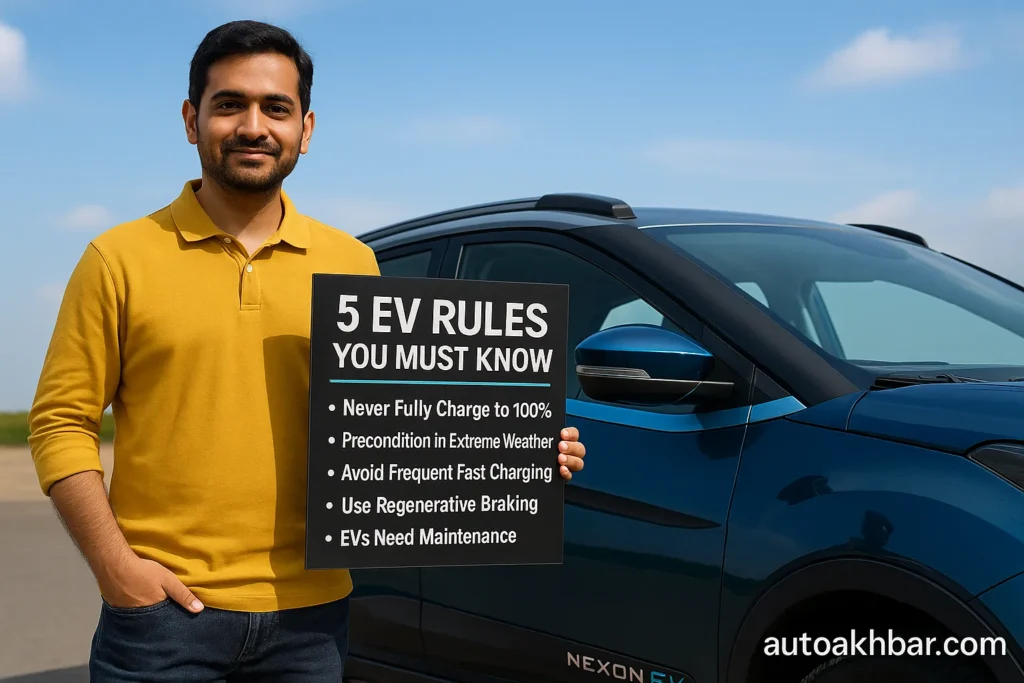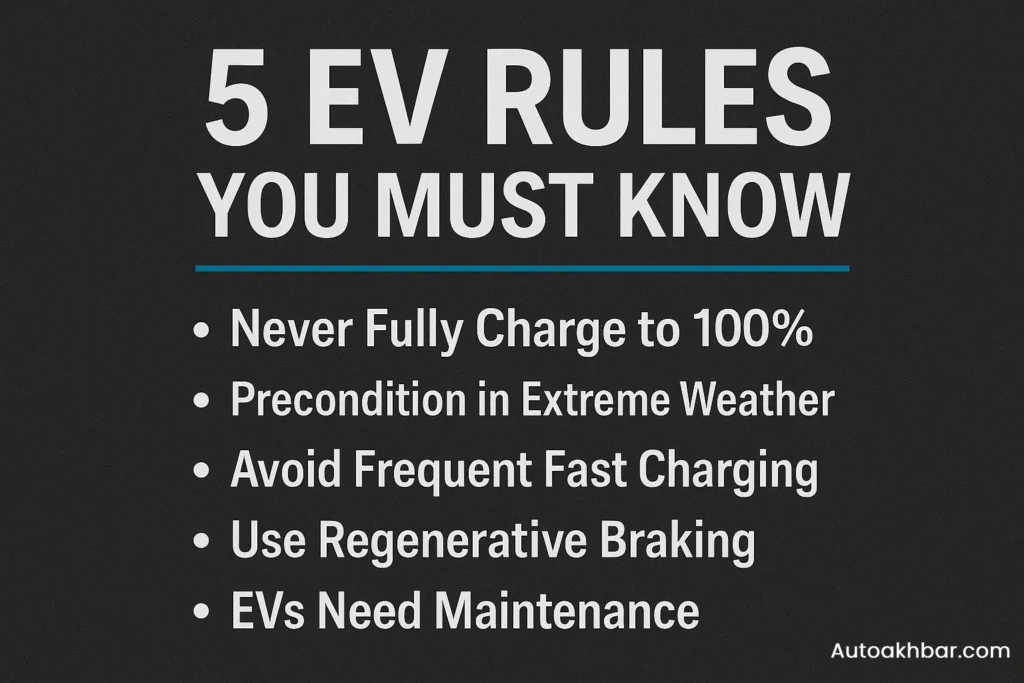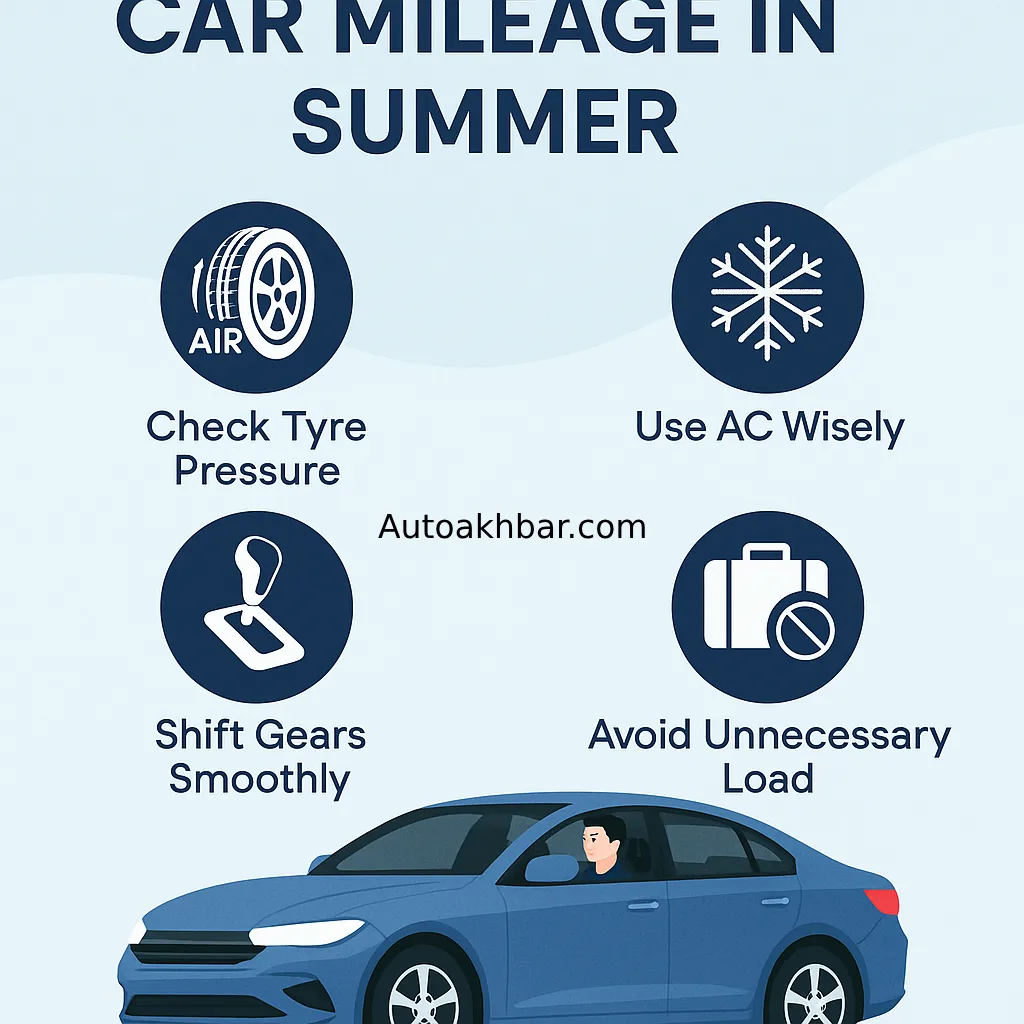⚡ Introduction
Electric vehicles (EVs) are no longer just a future trend—they’re becoming a common sight on Indian roads. But unlike petrol or diesel cars, EVs come with a different set of dos and don’ts. As an EV owner myself, I made some beginner mistakes early on. Thankfully, I learned quickly.
In this blog, I’ll walk you through 5 practical rules every EV owner in India must know in 2025. These tips can help you maximize your EV battery life, save money, and get the best performance out of your vehicle.
Let’s jump right in.

Table of Contents
🔋 Rule #1: Never Fully Charge to 100% – Stay Between 20% to 80%
Yes, it sounds strange—but it’s true. Keeping your battery between 20% and 80% charge is one of the best things you can do for long-term battery health.
🔍 Why it matters:
- Fully charging creates more heat and stress on the battery cells.
- Over time, this can degrade the battery faster.
- Most EV manufacturers recommend charging till 80% for daily use.
✅ Pro Tip: Use scheduled home charging to stop at 80%. Most EV apps like Tata, MG, and BYD offer this feature.
🔗 Also read: Yakuza Mini Electric Car – India’s $2999 EV Shocking the World

🌡️ Rule #2: Precondition Your EV Before Driving in Extreme Weather
Whether it’s Delhi’s scorching summer or Himachal’s freezing winter, temperature affects battery performance.
🔧 What is Preconditioning?
It’s a feature that prepares the battery and cabin before you start driving—usually via the mobile app or remote key.
- Precool in summer = saves AC energy
- Preheat in winter = maintains range
⚠️ Skipping this step can reduce range by up to 15%. Use it smartly before plugging out or starting your trip.
⚡ Rule #3: Avoid Frequent Fast Charging Unless Urgent
Fast charging is convenient, especially when you’re in a hurry. But daily fast charging is not healthy for your battery.
| Charger Type | Charging Time | Impact on Battery |
|---|---|---|
| Fast Charger | 60–90 minutes | Increases heat & stress |
| Home Charger | 5–6 hours | Safe, slow, reliable |
✅ Use fast chargers only on long highway trips or emergencies.
🔗 Compare: India’s Top EV Scooters 2025 | TVS iQube, Bajaj Chetak, Ola S1 Pro & More
🛑 Rule #4: Use Regenerative Braking the Smart Way
Regenerative braking helps convert your car’s motion back into battery power—but only when used correctly.
Best practices:
- Use it in urban stop-and-go traffic.
- Adjust regen level as per your driving comfort (most cars offer Low/Medium/High modes).
- Avoid aggressive regen on slippery roads—it can affect handling.
🔎 If your EV supports one-pedal driving, try practicing it to get the most from regen.
🧰 Rule #5: EVs Need Maintenance – Just a Different Kind
It’s true—EVs don’t need oil changes, but that doesn’t mean they’re zero-maintenance.
EV Maintenance Checklist (Every 6 Months):
- ✅ Brake pads (regen reduces wear, but not forever)
- ✅ Coolant for battery & motor (varies by model)
- ✅ Cabin air filter
- ✅ Tyre rotation
- ✅ Software updates (very important for range & safety)
💡 Skipping regular checkups may cost you more down the line—even if the upfront service cost is low.
🔗 Reference: Official Tata EV Maintenance Guide (PDF)
🙋 Frequently Asked Questions (FAQs) On EV Rules
Is it okay to fully charge an EV overnight daily?
No. Regular 100% charging increases battery stress and heat, which reduces its long-term capacity.
How often can I use fast charging?
Use it only when necessary—like road trips or emergencies. Stick to home charging for daily needs.
What is regenerative braking, and can it replace normal braking?
It slows down the vehicle using the electric motor, but you still need regular brakes, especially for emergency stops.


